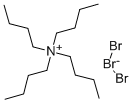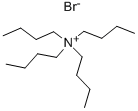| Identification | More | [Name]
Tetrabutylammonium tribromide | [CAS]
38932-80-8 | [Synonyms]
TBABR3
TETRABUTYLAMMONIUM BROMIDE PERBROMIDE
TETRABUTYLAMMONIUM TRIBROMIDE
TETRA-N-BUTYLAMMONIUM TRIBROMIDE
1-Butanaminium,N,N,N-tributyl-,(tribromide)
Tetrabutylammonium perbromide
Tetra-n-butylammonium tribromide, 98+%
Tetra-n-butylammonium Tribromide(TBAB)
TETRA-N-BUTYLAMMONUIM TRIBROMIDE
TETRABUTYLAMMONIUM BROMIDE PERBROMIDE (TRIBROMIDE)
TBABr3, Tetrabutylammonium bromide perbromide
Tetrabutylammonium tribromide ,98% | [EINECS(EC#)]
609-598-3 | [Molecular Formula]
C16H36Br3N-2 | [MDL Number]
MFCD00012110 | [Molecular Weight]
482.18 | [MOL File]
38932-80-8.mol |
| Chemical Properties | Back Directory | [Appearance]
orange crystalline powder | [Melting point ]
71-76 °C (lit.) | [density ]
1.5469 (rough estimate) | [refractive index ]
1.6500 (estimate) | [storage temp. ]
Keep in dark place,Inert atmosphere,Room temperature | [solubility ]
Acetone (Slightly), Chloroform (Slightly) | [form ]
Crystalline Powder | [color ]
Yellow | [Water Solubility ]
insoluble | [Detection Methods]
NMR | [BRN ]
3746114 | [InChI]
InChI=1S/C16H36N.Br3/c1-5-9-13-17(14-10-6-2,15-11-7-3)16-12-8-4;1-3-2/h5-16H2,1-4H3;/q+1;-1 | [InChIKey]
KEWPQWXPEDFWRU-UHFFFAOYSA-N | [SMILES]
[N+](CCCC)(CCCC)(CCCC)CCCC.[Br-](Br)Br | [CAS DataBase Reference]
38932-80-8(CAS DataBase Reference) |
| Safety Data | Back Directory | [Hazard Codes ]
Xi | [Risk Statements ]
R36/37/38:Irritating to eyes, respiratory system and skin . | [Safety Statements ]
S26:In case of contact with eyes, rinse immediately with plenty of water and seek medical advice .
S36:Wear suitable protective clothing .
S37/39:Wear suitable gloves and eye/face protection . | [RIDADR ]
UN3261 | [WGK Germany ]
3
| [HazardClass ]
8 | [PackingGroup ]
III | [HS Code ]
29211990 |
| Hazard Information | Back Directory | [Chemical Properties]
orange crystalline powder | [Synthesis]
General procedure for the synthesis of tetrabutylammonium tribromide from tetrabutylammonium bromide: A sample of molybdic acid monohydrate (H2MoO4) was taken. H2O (0.16 mmol, 0.029 g) in a 250 mL glass beaker and 30% hydrogen peroxide (H2O2, 15.52 mmol, 1.76 mL) was added to it. The mixture was stirred at room temperature for 30 min. The slightly cloudy solution was filtered through Whatman No. 1 filter paper on a glass funnel. The clarified filtrate was collected in a 250 mL glass beaker and kept in an ice water bath. Tetrabutylammonium bromide (TBAB, 15.51 mmol, 5 g) and potassium bromide (KBr, 31.01 mmol, 3.69 g) dissolved in 0.3 M H2SO4 (15.52 mmol, 51.77 mL) were slowly added to the solution under continuous stirring, resulting in the formation of a yellow precipitate. The mixture was continued to be stirred in an ice-water bath for 1 h and then left to stand in an ice-water bath for 2 h to give an orange-yellow compound of tetrabutylammonium tribromide (TBATB). The compound was separated by filtration using Whatman No.1 filter paper under suction. It was dried in melted CaCl2 and recrystallized from acetonitrile. The yield was 7.23 g (96.7%), melting point: 76-77°C. The chemical analysis, IR and conductance of the compound were in good agreement with the data reported in the literature. Analytical data: compound correctly analyzed C16H36NBr3: Calculated values C, 39.86; H, 7.52; N, 2.90; Br, 49.71%. Measured values C, 39.41; H, 8.28; N, 2.78; Br, 49.53%. | [References]
[1] Patent: WO2004/54962, 2004, A1. Location in patent: Page 10
[2] Patent: WO2004/54962, 2004, A1. Location in patent: Page 11-12
[3] Catalysis Communications, 2010, vol. 11, # 11, p. 992 - 995
[4] Synthetic Communications, 2015, vol. 45, # 6, p. 724 - 736
[5] Arkivoc, 2018, vol. 2018, # 7, p. 172 - 185 |
| Questions and Answers (Q&A) | Back Directory | [Uses]
- Tetrabutylammonium tribromide (TBATB) is a salt of the lipophilic tetrabutylammonium cation and the linear tribromide anion. It is used as a phase transfer catalyst in organic synthesis as well as a mild brominating agent. A wide range of O-isopropylidene derivatives can be prepared from the sugars and their derivatives on reaction with acetone at room temperature by employing 2 mol % of tetrabutylammonium tribromide as a catalyst. Good yields, low catalyst loading, mild reaction conditions, and a non-aqueous workup procedure are some major advantages of this protocol.
- Tetrabutylammonium tribromide as an efficient generator of HBr for an efficient chemoselective reagent for acetalization of carbonyl compounds.

- It is sometimes used as a reagent used in organic synthesis as a conveniently weighable, solid source of bromine.
- Tetra-n-butylammonium tribromide is useful for the preparation of vicinal dibromides from alkenes and alkynes and alfa-bromo acetals.
- it is utilized to generate hydrogen bromide, which is used as an efficient chemoselective reagent for acetalization of carbonyl compounds.
|
|
|







